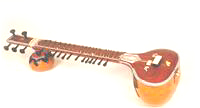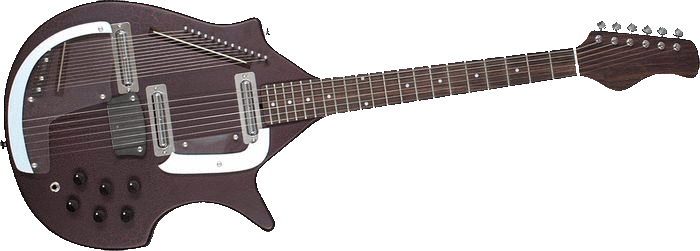Sitar


Chi Kari (drone & rhythm) strings which
are the uppermost on the sitar:
C (2 octaves above middle C)
G (in next lower octave)
C (1 octave above middle C)
Then the "Main Playing" strings which are
suspended directly over frets:
C (below middle C)
G (next G up)
C (Middle C)
F (next up)
The sympathetic strings which run below the frets
are tuned as follows:
C (above middle C)
B (1/2 step below)
C (again)
D
E
E (again)
F
G
A
A
B
C
The dominant notes in a Raga are tuned to two of the sympathetic
strings so that they will be stronger in the piece.
More Tunings
Another Sitar Tuning
The standard tuning is: #1-F 1 octave below middle C, #2-C 1 octave below
middle C, #3-C 1 octave below middle C, #4-G 2 octaves below middle C,
#5-G 1 octave below middle C, and the chi Kari #6 & #7 are middle C
& C 1 octave higher than middle C. The sympathetic strings are tuned
to the raga. The tuning I use is: Strings #6,7 (two strings closest to the
player - as in string #6 on guitar) are called chi Kari's. String #7 is
tuned to high C (2 octaves higher than middle C - C7). String #6 is tuned
to an octave higher than Middle C. String #4 is tuned to an octave lower
than middle C. Strings #2,3,5 are tuned to middle C. Finally, String #1 is
tuned to G5. The sympathetic strings are tuned in a standard C major scale
starting with a low G up to a high C or D.
Somewhat of a theory here:
The Indian music system is based on Ragas. The Indian music
notation is basically the same as the western system. However, there are
more notes. Each western major note has 2-4 different Shruti's. A Shruti
is a small cent gap in the pitch of a note which most people would not be
able to notice (as in a very small string pull on a guitar).
Playing The Sitar
First, instead of using a guitar pick, a Sitar player uses a 2 mizrabs, which is a metal finger pick (like steel pickers). One pick is placed on the index finger and the other on the pinky. If the player does not want to use a pick on his/her pinky, it is also common for them to grow their fingernail and use that instead. Just like a guitar player.
Second, the Sitar is similar to playing the Guitar although there are quite a few variations in the styles of playing. It's held similar to the Guitar but in a sitting position and their are different sitting positions. The bowl end sits on the leg, between the legs or on the floor.
Rogue STR-1 Pro Electric Sitar Guitar

Traditional Tuning:
The longest and lowest string is tuned an octave above the high E of a
standard tuned guitar. From there the strings are tuned in half steps. This
is just a starting point and experimentation can yield some beautiful
sounds.
Another great tuning is to use a "dropped D" tuning (dropping the 6th E
string down a full step to D) on the guitar neck; then the sympathetic
strings would be tuned to a D7sus chord as follows (longest string to
shortest string):
D - same note as 1st string of the guitar neck fretted at the 10th fret (the
1st string is tuned to standard E)
F# - ascending
G - ascending
A - ascending
C - ascending
A - ascending
G - ascending
F# - ascending
G - ascending
A - ascending
C - ascending
D - ascending
D - same as previous note